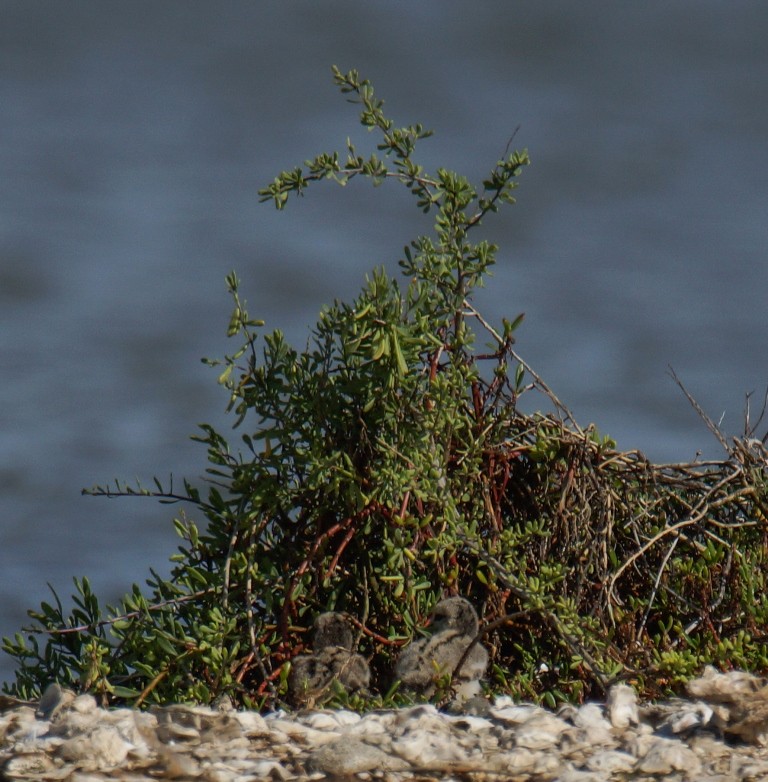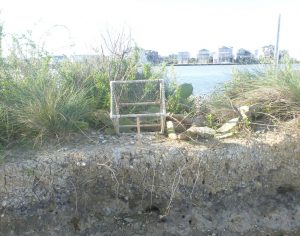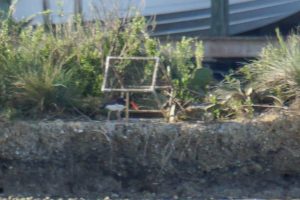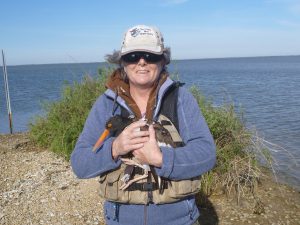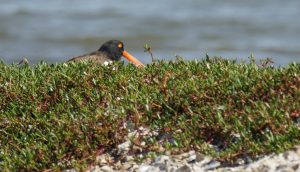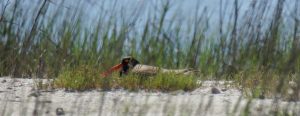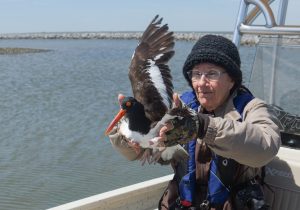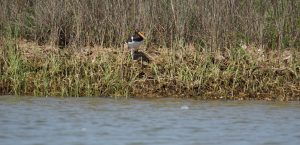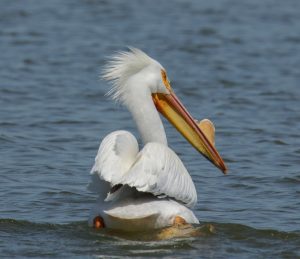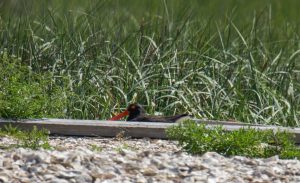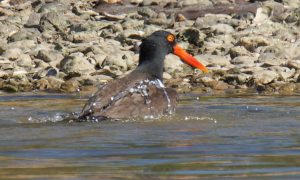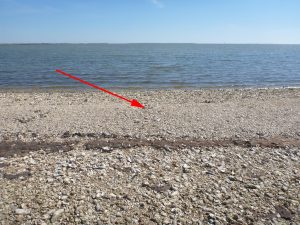By Susan Heath
On Wednesday I was joined by Alan Wilde, John Wright, and Stennie Meadours for my weekly tour of West Galveston Bay. Last week the pair near the boat ramp had a new nest and one of them is unbanded so I had hoped to use the box trap to remedy that situation. The nest is up on a mud bank with a cliff on one side and thick vegetation on the other but I was able to get the box set up there.
The unbanded bird had been incubating when we arrived so we watched hopefully as a bird returned to incubate. It took a couple tries for the bird to get up on the cliff edge with the box there but when it did, it went right in and was trapped.
Woohoo! Well not so fast. When I approached to take the bird out, I discovered it was the banded one! Dang. R3 was banded early in our study on March 26, 2011. We don’t know his exact age but since he was breeding when we banded him he was at least three at the time. That means he’s at least 10 now and is probably older. He is showing his age as he looked a bit ruffed up. Poor guy!
We let him go back to his duties and moved on. We had intended to go up to Swan Lake but the railroad bridge was down so we checked the islands near there. All was well on Struve Luci with two pairs with confirmed chicks and one pair with suspected chicks. We only saw the chicks from one pair (HM & X7).
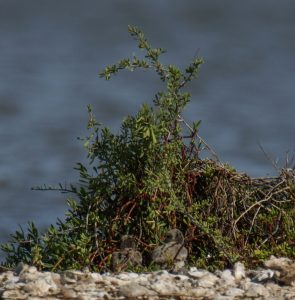 photo by Alan Wilde
photo by Alan Wilde
12 & unbanded are really stubborn about letting us see their chick but we had a few tricks up our sleeves. More on that later.
On Jigsaw T5 & T6 were incubating and the other two pairs were loafing on a reef. The bridge was still down so we zipped back over to Struve hoping to catch 12 & unbanded unaware since we’d already been there and I guessed they wouldn’t be expecting us to return. I was right! Their chick was up on the ridge line but quickly hid behind a large shell as Alan was trying to get some photos. At least we saw it and we know it’s still alive! We headed for the rest of the islands in that area. We looked hard for 16 & unbanded and finally I spotted one of them clearly incubating a new nest up on the shell ridge line. Yeah! We did not go up and check it out to keep it from being discovered by mammals in the area. At Gangs Bayou we discovered a bird incubating a nest on one of the sand mounds that were created behind the new breakwater and another incubating a nest on the island itself.
I decided to see if we could get the boat over to the sand mounds so we could set up the box on the nest there. No problem! We set up the box and waited and waited and waited. Finally the bird went in. I have run out of two character codes, so this bird was the first adult banded with a three character code band (in a triangle pattern). Here is Stennie letting A1A (aka Mr. Key West) go.
He was pretty happy to get back to his eggs. The railroad bridge was finally up but since we were in the area I wanted to check South Deer first. KK & unbanded’s nest had hatched and they went nuts when we approached so we motored on and wished them well. We will likely see the chick(s) in a few weeks when they are older. LL & unbanded were still incubating. At some point in there we noticed that the railroad bridge was down again! I think I saw that thing go up and down more times today than I ever have before. When we got to 13 & unbanded’s territory they were nowhere to be found and then suddenly there they were right on shore. How do they do that? There were four of us on the boat and none of us saw where they came from. Sneaky, sneaky. I searched for a nest but found none. While we were watching, a gang of give non-breeders flew in and landed on 13 & unbanded’s reef. Uh oh. 13 & unbanded got all up in arms and flew over and started giving the gang their best cocked tail display maneuvers.
Eventually they chased them all off. JN & UW were still incubating but HL & L4 were not. Last week they had three eggs. This week only one was left. Did it hatch? Nope. The Laughing Gulls got the eggs. I found a broken egg shell near the nest. Dang it! Magically the railroad bridge was back up so we high-tailed it up there and checked on Swan Lake. The two pairs along the shoreline on the way were not home. K7’s unbanded mate was standing in the vegetation and K7 flew in and starting giving us the business when we approached so I knew their nest had hatched.
We left them be. Last year this pair kept their chicks hidden from us until they fledged and so they did not get banded. This year I am determined to not let that happen again! We discovered this punked out white pelican on the way to check the other pairs.
Did you know that American White Pelicans get that bump on their bill during the breeding season? No one knows why or what it’s for! Nothing else was happening up there except that L5 was still alone on the breakwater. Tough luck buddy. You’ll find a new mate soon!
We managed to make it back to West Galveston Bay before the bridge went down again. Phew! Over by North Deer and Marker 52 we found that JR & JH had a new nest strategically positioned between two old pieces of lumber.
23 & UW also had a new nest and H0 & JC were still incubating theirs. We came upon H0 taking a bath which was pretty entertaining!
In Jones Bay we found that CA & Y2 also had a new nest and P3 & unbanded were still incubating their cactus nest. I’m very happy with their nest placement this time! It is up high and so hopefully won’t overwash. Well done guys. The very last surprise of the day was finding that FR & unbanded had a nest on their island which is basically a reef now. They put it up as high as they could but sadly that is not very high.
Unfortunately it was too windy the rest of the week to get out on the boat so I was not able to survey East Matagorda Bay this week.
We are adopting out pairs of birds again this year as fund raiser for this project. We greatly appreciate all who have adopted pairs in the past! If you aren’t familiar with the program – you can adopt a pair of oystercatchers for a $100 donation and I will update you monthly on their progress throughout the breeding season. Most pairs are from West Galveston Bay, but there is a pair from Dickinson Bay and a pair from Swan Lake too. If you want a pair from East Matagorda Bay let me know.
Current Stats for upper Texas coast from Dickinson Bay to East Matagorda Bay: 17 nests being incubated, 3 failed nests, 6 nests with unfledged chicks, 0 nests with undetermined status, 0 chicks fledged
This project is supported by the National Fish and Wildlife Foundation and several private donors. If you would like to contribute you can call our office for information on how to do so (979-480-0999). All donations are tax deductible and GREATLY appreciated.
Note: All trapping and banding for this project is in accordance with federal and state permits issued to Susan Heath, GCBO Director of Conservation Research. Bird handling by volunteers is only permitted in the presence of Susan Heath and volunteers are trained in proper bird handling techniques.

